
Déclaration de consensus du Centre climatologique régional de l’Arctique : Température
– Par Gabrielle Gascon1, Katherine Wilson1, Marko Markovic1*, Adrienne Tivy1, Bill Appleby1, Vasily Smolyanitsky2, Valentina Khan3, Helge Tangen4, Eivind Stoylen4, Lene Ostvand4, Johanna Ekman5, Arun Kumar6 and Shanna Combley6 –
Résumé saisonnier estival 2019 pour l’Arctique et aperçu saisonnier 2019-2020 des températures hivernales pour l’Arctique
Les températures de l’Arctique continuent de se réchauffer à une vitesse supérieure à deux fois la moyenne mondiale. Au cours des quatre dernières années (2014-2018), les températures annuelles de l’air en surface dans l’Arctique ont été les plus élevées jamais enregistrées depuis 1900. L’étendue de la glace de mer hivernale se trouve réduite comme jamais, et le volume de glace de mer arctique présente en septembre a diminué de plus de 50 % par rapport à la valeur moyenne de 1979 à 2018.
Pour aider les décideurs responsables de l’Arctique, dans le contexte des changements climatiques, le nouveau réseau du Centre climatologique régional de l’Arctique (ArcRCC) fournit maintenant des déclarations de consensus sur le climat, et ce, en mai avant le dégel et la fracture de la glace, ainsi qu’en octobre avant le gel et le retour de la glace de mer. L’ArcRCC facilite la collaboration entre les services météorologiques et des glaces responsables de l’Arctique, et vise à synthétiser les observations, les tendances passées et les modèles de prévision, et à combler les lacunes grâce à l’expertise régionale, afin de produire un consensus sur le climat. Ces déclarations consensuelles fournissent une revue des principales tendances du climat de la saison précédente et des aperçus de la saison à venir en ce qui concerne la température, les précipitations et la glace de mer. Elles sont émises en mai, pour les utilisateurs de l’Arctique, dans le cadre du Forum sur le climat dans l’Arctique puis en octobre par l’entremise d’une version virtuelle en ligne du Forum.
Principaux points du consensus : un fort anticyclone persistant dans la région arctique entre juin et août 2019 a contribué à une température de l’air en surface supérieure à la normale. On prévoit des températures supérieures à la normale et des conditions plus sèches que la moyenne pour toutes les régions arctiques entre novembre 2019 et décembre 2020.
Highlights
A strong persistent high-pressure system over the Arctic region between June and August 2019 contributed to the above normal surface air temperature observed in the region. Above normal temperatures and drier-than-average conditions are forecast for all Arctic regions between November 2019 and December 2020.
The summer 2019 (JJA: June, July, August 2019) average surface air temperatures were above normal for most of the Arctic domain, with Eastern Siberia experiencing its warmest JJA on record. Exceptions are north central Canada and the northwestern part of Russia, where average surface air temperatures were below normal. Above normal temperatures are expected to continue across the majority of the Arctic regions between November 2019 and January 2020.
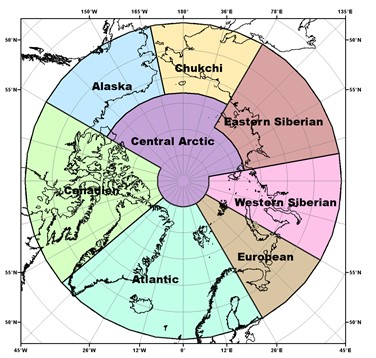
Understanding the Consensus Statement
This consensus statement includes a seasonal summary and forecast verification for temperature for previous 2019 Arctic summer season. This statement also includes an outlook for the upcoming 2019-2020 Arctic winter season. Figure 1 shows the regions that capture the different geographic features and environmental factors influencing temperature.
The temperature forecast is based on thirteen WMO Global Producing Centers Long-Range Forecasts (GPC-LRFs) models. In terms of models’ skill (i.e. the ability of the climate model to simulate seasonal climate), a multi-model ensemble (MME) approach essentially overlays all of the separate model performances. This provides a forecast with higher confidence in the regions where separate models agree (regions where models have same result), versus a low confidence forecast in the regions where the models don’t agree. The multi-model ensemble approach is a methodology reputed as providing the most reliable objective forecasts.
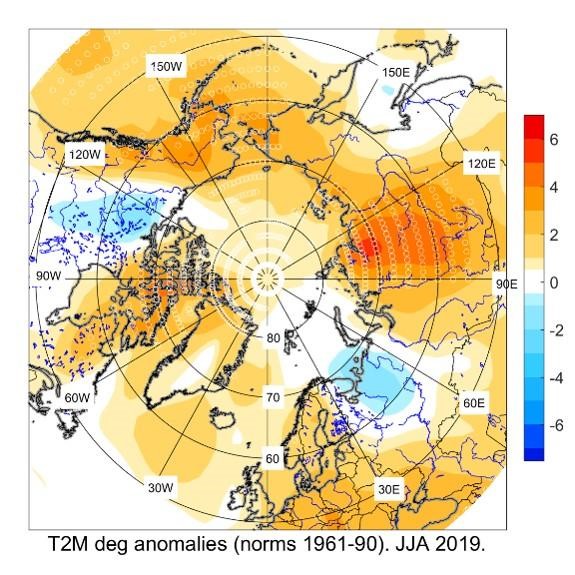
Temperature Summary for Summer 2019:
The June, July and August (JJA) 2019 average surface air temperatures in the Arctic north of 65°N was above normal in most regions, with the exception of north central Canada and the northwestern part of Russia (Figure 2). Eastern Siberia saw their warmest JJA since the start of the record in 1936, while most of the Chukchi, Central Arctic, and Alaskan regions saw their second warmest JJA on record. Using data from NCEP/NCAR reanalysis to rank the average surface air temperature, the JJA period ranged from the top 10 warmest over parts of Alaska, Chukchi, the northern Canadian Arctic, and most of Eastern Siberia, to the 10th coldest in small areas of the western Canadian Arctic and northwestern Russia regions since the start of the record in 1949 (not shown).
The Summer 2019 temperature forecast was verified by subjective comparison between the forecast (Figure 3, left) and re-analysis (Figure 3, right), region by region. A re-analysis is produced using dynamical and statistical techniques to fill gaps when meteorological observations are not available.
Above-normal surface air temperatures over western Alaskan, western Siberia, and the Chukchi region, were accurately forecast for the JJA 2019 season (Figure 3, Table 1). The above normal surface air temperature forecast for the northern Canadian region was also accurate. Over the Atlantic region, the forecast accuracies were variable but above-normal temperatures over the ocean for the region were accurately forecast. The observed below temperatures over eastern Alaska and the European region (blue areas in Figure 3, left) were not accurately forecast. Additional areas with an incorrect surface air temperature forecast included most of the Eastern Siberia, the southwestern parts of the Canadian Arctic, and eastern Alaska. As a general conclusion, the multi-model ensemble forecast was accurate for approximately 50-60% of the Arctic territory.
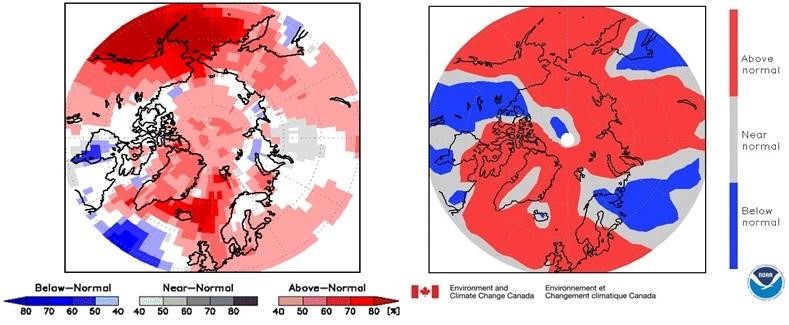
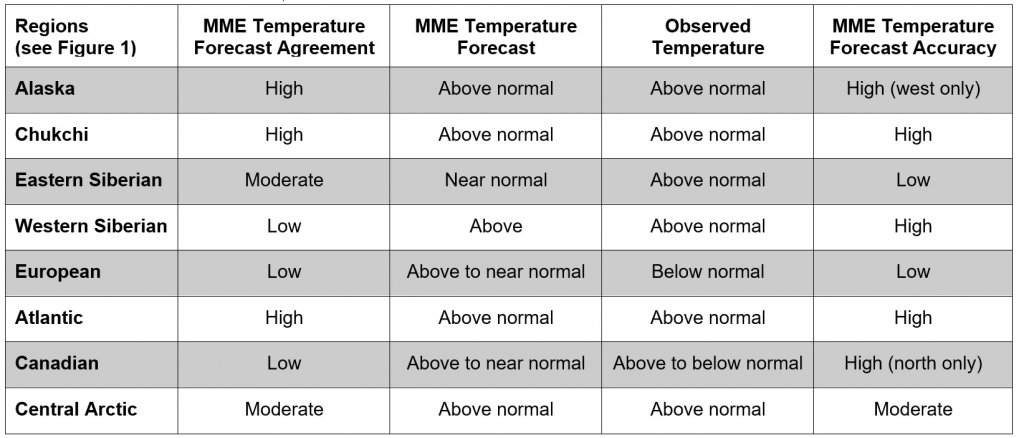
High=80%+, Moderate=50-70% and Low=<40%
Temperature Outlook for Winter 2019-2020:
Surface air temperatures during winter 2019-2020 (NDJ: November 2019, December 2019, January 2020) are forecast to be above normal across the majority of the Arctic regions (orange and red areas in Figure 4). The confidence of the forecast is moderate to low over most of the southern Arctic, especially over the southern continental Alaska, Canadian, European, Chukchi, Western and Eastern Siberian regions. (yellow and orange areas in Figure 4, Table 2). Forecast confidence increases with latitude from low/moderate to moderate/high for all regions (dark red areas in Figure 4, Table 2). The multi-model ensemble did not agree over southern Greenland (white areas in Figure 4).
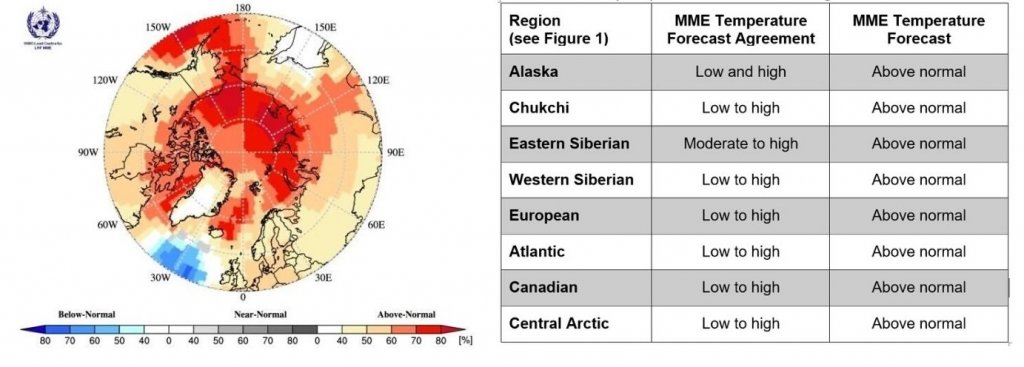
Right) Table 2: Winter (NDJ) 2019-2020 Outlook: Regional Forecasts for Arctic Temperatures
Background and Contributors
This Arctic seasonal climate outlook was prepared for ACF-4. Contents and graphics were prepared in partnership with the Russian, United States, Canadian, Norwegian, Danish, Finnish, Swedish, and Icelandic meteorological agencies and contributions of the Expert Team on Sea-ice, an expert team of the Joint WMO/IOC Technical Commission on Oceanography and Marine Meteorology, CCl/CBS Joint Expert Team on Regional Climate Centres, the Global Cryosphere Watch, the International Ice Charting Working Group, and with input from the Arctic Monitoring and Assessment Programme (AMAP).
The ArcRCC is in demonstration phase to seek designation as a WMO RCC-Network, and products are in development and are experimental. For more information, please visit www.arctic-rcc.org.
Author Affiliations:
1. Environment and Climate Change Canada
2. Arctic and Antarctic Research Institute, Russia
3. Hydrometeorological Centre of Russia, Russia
4. The Norwegian Meteorological Institute, Norway
5. Finnish Meteorological Institute, Finland
6. Climate Prediction Center, National Oceanic and Atmospheric Administration, USA
*About Marko Markovic, Corresponding Author:

Marko completed his PhD in atmospheric science at UQAM (2011) under the supervision of Dr. Hai Lin (RPN, Environment Canada). His PhD research encompasses seasonal forecasting and the research of low frequency atmospheric variability. After completing his doctoral degree Marko joined Consortium Ouranos as a postdoctoral fellow working on climate change related projects. Between 2012 and 2014, as a Consortium Ouranos employee, Marko has worked on the representation of the Arctic climate simulated by the latest generation of global climate models.
Marko joined ECCC in 2014 and his current work is focused on production and evaluation of seasonal forecasts, issued by Canadian Seasonal to Interannual Prediction system. Marko’s office is in Canadian Meteorological Centre (CCMEP) located in Montreal/Dorval.
Plus comme ça:
- Travailler ensemble pour l’environnement arctique : mise sur pied du Centre climatologique régional en réseau pour l’Arctique
- Prévision saisonnière SPISCan-CFSv2
- Isachsen – Un artiste, au travers des yeux de son père, fait une réflexion sur l’isolation à une station météorologique à distance de l’Arctique
ArcRCC, Arctic, changement climatique, Environnement et Changement climatique Canada, Marko Markovic